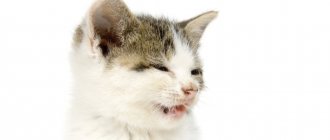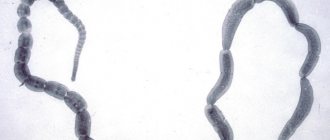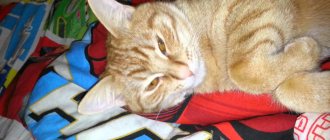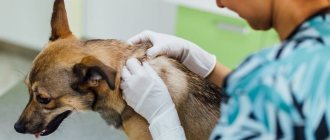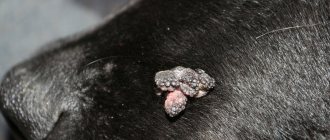12830Administration
If the cat is breathing heavily and wheezing, then this indicates a serious illness. It is necessary to pay attention to the characteristics of the symptoms. For example, when a cat breathes normally, the animal's chest rises and falls. In this case, the process occurs calmly, without jerks or convulsive movements.
However, if the cat begins to breathe from the stomach and sides, this means a disruption in the functioning of the respiratory tract. It is painful for the animal to exhale and inhale, as it does in a normal state. An even more alarming syndrome is when wheezing is added to the symptoms listed above.
© shutterstock
What breathing is normal?
Normal breathing in a cat is a calm and uniform rise and fall of the chest, without jerks or convulsive movements. If a cat breathes from its stomach and sides, this means that the respiratory tract is impaired, and it is painful for the pet to breathe naturally. Worry should be caused by the appearance of wheezing or loss of voice.
If a cat wheezes, it means he is sick with something.
Note! If a cat wheezes quietly while breathing during sleep, and there are no convulsive sighs or wheezing, this is normal.
Symptoms
A life-threatening sign is intermittent inhalation and exhalation with coughing.
- Cat wheezing - manifested by noises, whistling due to narrowing of the airways. They arise both due to the accumulation of excess fluid - hydrothorax, and a large amount of air - pneumothorax. With obstruction, gurgling sounds may be observed in whistling and wheezing.
- Coughing is a protective reaction due to which the respiratory canals are cleared of foreign objects, pus, mucus, fluid and other irritants. May occur due to a cold or have other dangerous causes.
- When breathing, the cat not only wheezes, but also has hoarseness - a very dangerous symptom. The voice may deepen due to the growth of a malignant neoplasm, and a cough with blood clots in the mucus may additionally appear, and the cat wheezes when breathing.
Signs of wheezing
The cat is breathing with its mouth open: what is the reason and what can be done
Wheezing is understood as noisy breathing, against the background of which a combination of many wheezing and whistling sounds is heard. Such deviation from normal breathing is a frequent companion to most pathologies of the animal’s respiratory tract.
Wheezing can occur for two reasons:
- in the process of narrowing the lumen of the respiratory tract;
- due to the accumulation and foaming of fluid in the respiratory system.
Noises and wheezing when breathing do not bode well
In addition, wheezing means a hoarse, strained voice or its complete absence. This pathology occurs due to incomplete closure of the vocal cords due to the accumulation of mucus in the glottis, which is a common symptom of many inflammatory processes.
The cat is breathing heavily and wheezing
Reasons that lead to loss of voice:
- Respiratory diseases are one of the common causes of wheezing when breathing in a cat. We are talking about various viral and infectious diseases that can be picked up by hypothermia in the cold season. It could be a cold or acute respiratory infection.
- Advanced respiratory diseases can lead to the development of pneumonia, viral feline rhinotracheitis, tonsillitis, calcivirosis or bronchial asthma, a common symptom of which is also loss of voice and wheezing.
- A foreign body in the larynx mechanically damages the surface of the pharynx due to the inability to swallow or regurgitate. This ultimately leads to the cat wheezing when he breathes. A pet can injure its throat with a thin or broken chicken bone, a tree branch, or choking on a spruce needle. Such damage is dangerous due to the high probability of a foreign object entering further into the digestive tract, injuring the upper respiratory tract and esophagus.
- Heart pathology. If the cat begins to show less activity, preferring to lie down instead of playing, walks slowly towards the bowl, as if overcoming obstacles, and upon reaching the goal, chokes, coughs or sneezes, this may be a sign of the development of heart pathologies. Often, owners are not even aware of the onset of heart problems in their cats due to the absence of symptoms. The disease develops, the body reaches a critical point, and after that symptoms appear and increase exponentially. A hoarse cat suffers from severe shortness of breath even after the slightest exertion. She has cold paw pads and ears, pallor of visible mucous membranes (gums, palate, eyes) due to poor blood circulation, in severe advanced cases, audible wheezing in the cat and bubbling in the chest, cold surface of the skin throughout the body.
The cat is trying to vomit a small object stuck in its throat
- Blood pathologies with a lack of iron in the body can also cause difficulty breathing with wheezing.
- With asthma, a cat wheezes and wheezes, presses to the floor, coughs, stretching its neck. As the disease progresses, severe shortness of breath and wheezing, even suffocation, appear.
- Pulmonary edema in a cat is an abnormal accumulation of fluid in the lungs, which is a consequence of various diseases of the internal organs and inflammatory processes. In this case, the cat wheezes when breathing with gurgling. He feels lethargic, phlegmatic, and desires to constantly sleep. The pet opens its mouth slightly with its tongue hanging out when breathing, inflating its belly and sides, trying to squeeze out liquid by coughing and swallowing; when coughing up, traces of blood, a bluish tint to the oral mucosa, and mucus from the nose may appear. A common urge of a cat is to expand its chest by standing in a position with its paws spread wide apart. Deterioration of the condition forces the cat to stretch out on its side.
- The accumulation of large amounts of fluid can be not only in the lungs, but also in the abdominal cavity. This pathology is called abdominal ascites, or dropsy. The pressure of the accumulated fluid compresses the internal organs, disrupting their activity. If dropsy is not treated in time, it can lead to the death of your pet.
Asthma can cause your cat to suffocate if you don't take action.
- The kitten wheezes when breathing with swelling of the larynx or laryngospasm, which appears due to poisoning with household chemicals. Such wheezing may be caused by an allergic reaction to tobacco smoke, dairy products, construction dust or strong odors.
- Oncology. From the second stage onwards, cancer is characterized by dysfunction of the respiratory system: the cat breathes heavily with wheezing, shortness of breath.
- Injuries due to improper handling by the owner, a fight with other cats, or an unsuccessful fall can cause damage to internal organs, including the respiratory system, so the cat may become hoarse.
- Tracheitis occurs due to many reasons: hypothermia, infection with a viral or bacterial pathogen, overdrying of the trachea during sleep during the heating season, evaporation of construction and paint materials. A strong barking cough and sore throat cause pain for the cat and cause loss of voice.
Causes of wheezing with heavy breathing
This is noisy bubbling breathing. It can occasionally be caused by a cold, and also accompanies most diseases of the respiratory system. A cat often wheezes for the following reasons :
- foaming of accumulated liquid (blood, trans- or exudate);
- the gaps in the respiratory tract narrow.
When the animal loses its voice, it wheezes for a long time. This indicates a violation of the vocal cords, their incomplete closure. The animal will wheeze until they are fully recovered. This phenomenon occurs when mucous fluid accumulates in crevices or with laryngitis.
Changes in a cat's breathing may be a consequence of obesity. In this case, even after little physical activity the animal breathes heavily. Sudden wheezing may indicate that the cat has swallowed a foreign body that is stuck in the throat. You can't try to pull it out on your own. Why can't pet owners do this? Without qualified help, the object can be pushed even further and the animal will die.
Diagnosis of the condition
The cat is coughing: why it wheezes, the reasons, as if it was choking
If the owner notices that the cat is breathing with difficulty, is very weak, apathetic and does not respond to anything, has severe injuries, has lost weight or has a serious illness (asthma, heart disease, etc.), it is necessary to urgently visit a veterinarian who has the necessary equipment and experience in providing assistance.
A weak, lethargic cat with trouble breathing should definitely be shown to a veterinary clinic.
During the trip, you need to check the cat’s breathing; if you can’t hear it, you can put a mirror against its nose or mouth. A foggy surface is evidence of breathing. You should also check the heartbeat in the chest and the pulse on the inside of the thigh. If breathing or heartbeat stops, you will have to start CPR yourself.
Diseases of other body systems that cause hoarse breathing
Respiratory wheezing can also be observed with other chronic or congenital pathologies of organs and body systems in a cat:
- cardiovascular diseases and heart failure;
- diaphragmatic hernia;
- kidney failure, which can cause pulmonary edema due to fluid accumulation;
- genetic malformations of the respiratory system: brachycephalic syndrome - in which there is a narrowing of the nasal passage, elongation and thickening of the soft palate; collapse of the trachea - when there is deformation of this organ, which is accompanied by loss of muscle elasticity and narrowing of the respiratory lumen.
The cat is choking and wheezing: what to do
Seizures in a cat: causes, what to do, treatment
You need to open the mouth and pull the tongue forward, check the throat for foreign objects that should be removed, including mucus or vomit. This will help clear your airways. To do this, hold the cat by its hind legs and raise its head.
Important! If you suspect a spinal injury, you should not lift or move the animal.
If removal of the foreign body does not help, you must begin first aid.
First aid for respiratory arrest
Step-by-step instruction:
How to give artificial respiration to a cat
- Start artificial respiration: lay the cat on its side, pull the tongue forward, cover the mouth with your hand and straighten the neck. Air is inhaled through the cat's nose every 3 seconds. It is important that the chest rises, but does not arch from excess inhaled air.
- During artificial respiration, you need to check for a heartbeat. If the heart is beating but there is no breathing, you need to inhale air at a rate of 10 breaths per minute until the cat breathes on its own.
- If you are completely sure of cardiac arrest, begin chest massage.
- If respiratory arrest is detected and resuscitation begins, it is important that someone call a veterinarian or take the cat and its owner to the clinic.
Important! Cardiopulmonary resuscitation should not be performed if the cat is conscious.
Instructions on how to perform chest compressions on a cat
Symptomatic treatment
If your cat starts wheezing, you should take her to the vet as soon as possible. The specialist will evaluate the clinical picture. To make a correct diagnosis, it is important to distinguish between wheezing, which comes in several types:
- Fine bubbles, which occur in bronchopulmonary diseases and are caused by sputum. It is phlegm in the respiratory system that causes the formation of tiny bubbles, from which wheezing and coughing can be wet and frequent.
- Medium bubble. In this case, the cat breathes harder. Her wheezing sounds like air being blown through a straw. They are whistling and loud. Such wheezing is caused by prolonged bronchitis, in which there is too much mucus in the bronchi, it is viscous and difficult to separate. Fibrous changes and pneumosclerosis can also cause medium-bubble wheezing.
- Large bubbling rales. Even a layman can hear them. They occur with swelling of the respiratory organ and are accompanied by a weak cough.
Next, the veterinarian will take standard blood, stool, and urine tests. If a serious illness is suspected, a biopsy (if a malignant tumor is suspected), ultrasound, computed tomography, or x-ray is prescribed.
There is no specific treatment for wheezing. Doctors are struggling with the cause of this condition. After making a diagnosis, the specialist prescribes medications.
Thus, the most common cause of wheezing is inflammatory processes, which are treated with antibiotics.
Foreign bodies and tumors are removed promptly, and antibacterial therapy is also carried out after the procedure.
Antihelmintic drugs are used to kill worms. But here it is important to treat all people who came into contact with the cat. It is also important to follow the veterinarian’s recommendations: the drugs are not taken once, as is often done when self-medicating, but repeated after 3 weeks. This is necessary in order to destroy the eggs that have managed to lay eggs.
For heart and kidney diseases, it is important to strictly follow your doctor’s recommendations. Drugs for the treatment of these pathologies have serious contraindications, so dosage errors can aggravate the painful condition.
Therapeutic techniques
In the clinic, after clearing the airways, the veterinarian can start breathing using artificial respiration, inserting an endotracheal tube and connecting to a ventilator. An indirect cardiac massage, a defibrillator and injections of drugs (adrenaline, atropine, atipemazole, etc.) help a specialist to start a stopped heart. Depending on the results of resuscitation efforts, studies are prescribed to establish a diagnosis, treatment and further care.
Regular preventive examinations and tests will help identify diseases in the early stages, without leading them to a chronic form. If you have congenital or chronic diseases, you should follow your veterinarian's recommendations for caring for your cat. An attentive and caring owner will always notice suspicious symptoms and seek advice from a specialist, because the life and health of the cat is in his hands.
Symptomatic diet and procedures
Cats with respiratory problems should have free access to water. And you should receive more water than usual, unless the veterinarian prescribes otherwise. If it is possible to humidify the air, it is worth doing so. This procedure will help the secretion drain.
In case of respiratory failure, foreign bodies, or asthma, you cannot force the animal to drink. If there is respiratory failure, your veterinarian may remove excess fluid from the lungs. In some cases, surgery may be required.
Antitussive treatment should be prescribed by a doctor.
In the case of an infectious disease, the cat needs specific treatment. Animals should not be given vodka or antibiotics for humans.
If foamy and bloody discharge appears from the nose, the cat should be taken to the hospital as soon as possible. Without timely help, the animal may die.
When the treatment is carried out efficiently and the animal is on the mend, it is important to support its weakened immune system. To do this, you need to supplement your diet with balanced vitamin and mineral complexes.
It is important to feed your cat a balanced diet rich in fats, proteins and carbohydrates.
Wheezing is an unpleasant phenomenon. But with timely consultation with a specialist, adequate treatment and strict adherence to recommendations, a return to normal is possible. The main thing is to show care, treat your pet with love and attention.
Allergic manifestations
Allergies are common among tailed pets. An allergen entering the body during breathing provokes an immune system reaction characterized by irritation and inflammation of epithelial cells, swelling of the mucous membrane of the respiratory tract and accumulation of exudate in the bronchi. As a result, the cat:
- has difficulty breathing through the nose;
- breathes through an open mouth;
- makes wheezing, grunting and coughing sounds.
Allergens:
- dust;
- household chemicals;
- chemical preparations for ectoparasites;
- tobacco smoke;
- aerosols and any flavored perfumes;
- cat litter;
- paint and varnish products;
- flower pollen.
Associated symptoms. Difficulty breathing due to allergies is accompanied by:
- sneezing and watery discharge from the nasal passages;
- redness of the eyes and watery eyes;
- itching and the need to constantly rub the face with your paws;
- redness in the throat, dry cough and difficulty swallowing;
- skin and coat problems.
Nature of manifestations. The severity of respiratory allergic manifestations can vary and may include:
- allergic laryngitis and tracheitis;
- allergic bronchitis;
- bronchial AS src=»https://porodakoshki.ru/wp-content/uploads/2019/10/Virusnye-zabolevaniya-dyhatelnyh-putej-e1571507833171.jpg» class=»aligncenter» width=»600″ height=»338″ [/img]
In the latter case, the animal suffers from episodic attacks of suffocation caused by bronchospasm, swelling of the respiratory tract mucosa and excessive mucus production by the bronchial epithelium. At such a moment, it seems that the animal cannot take a breath, breathing with wheezing and whistling.
Asthma most often affects adult cats aged 2 years and older.
Methods of therapy. To relieve allergy symptoms, the veterinarian prescribes antihistamines and corticosteroids, and for asthma, special aerosols. An allergic cat must be kept at a comfortable temperature with humidification, preventing the inhalation of dust, tobacco smoke and other substances hazardous to it.
Are cats prone to snoring?
Cats are much less susceptible to this phenomenon than dogs or even humans. However, certain breeds of cats with short, flat faces are prone to snoring. They may snore quite loudly in their sleep. These are Persian, British, Scottish, Himalayan, all kinds of exotics. For these breeds, snoring during sleep is normal and is called brachycephalic syndrome. It occurs due to short sinuses.
In some cases, brachycephalic syndrome can cause surgery when the cat becomes very difficult to breathe and snores. Beauty, as they say, requires sacrifice. Breed characteristics in domestic cats are sometimes too pronounced and prevent them from enjoying a full life.
Cats with a normal muzzle shape are another matter, especially in a situation where snoring appears suddenly. However, you need to know that diseases, one of the symptoms of which is snoring, are highly treatable, so there is no need to panic. However, it is imperative to get rid of this unpleasant phenomenon.
© shutterstock
Treatment in clinical and home settings
Whatever the diagnostic methods, they should be carried out in the clinic. Treatment should be prescribed based on the results of clinical and laboratory tests. It may consist of the following:
- antibiotics (for inflammatory processes);
- expectorants and mucolytic drugs;
- antiviral drugs (for viral infections);
- immunomodulator drugs;
- surgical intervention (stenting) for tracheal collapse;
- anthelmintics when detecting helminthic infestation.
The owner of the animal can independently, at home, give the cat a tablet, syrup, or administer intramuscular medication prescribed by the doctor.
If the treatment involves surgery, the clinic will provide it, as well as care in the postoperative period.
Pleurisy
Pleurisy is the accumulation of fluid in the space between a cat's lungs and the chest wall. Occurs mainly due to heart failure, infectious peritonitis, neoplasia. The latter involves the accumulation of pus in the pleural cavity. In these cases, the cat has serious breathing problems and a wheezing sound appears due to the inability of the lungs to expand properly. In addition to wheezing and coughing, the cat develops restlessness and bluish mucous membranes of the tongue. Treatment of pleurisy should begin immediately, immediately after detecting any of the clinical signs and confirming the diagnosis.
Diagnosis of the respiratory system: how a veterinarian determines the presence of diseases
Most often, diagnostics of the respiratory system is carried out using a combined method; a specialist can use several methods at once:
- Auscultation (listening to the chest organs). All you need is a phonendoscope. The method allows you to detect wheezing in the lungs and bronchi.
- Percussion (tapping the chest). In this case, an experienced specialist can quite accurately determine the boundaries of organs, the presence/absence of fluid, etc. Note that the study can give good results only in cases where the qualifications of the specialist performing percussion are sufficiently high.
- X-ray. The technique is simple and cheap; equipment for its implementation is available in almost every large veterinary clinic. However, sufficiently high-quality images can be obtained only if special contrast compounds are introduced into the animal’s blood before the study. The pictures are clearer and it is easier to notice signs of pathologies.
- Ultrasound examination of the chest organs. The technique is also common and, moreover, can provide better data, since the method is excellent for soft tissue studies. But ultrasound is a method, the result of which depends even more on the qualifications of the performer. Therefore, the breeder’s task is to select a really good specialist.
What is snoring from a physiological point of view?
In some cases, a cat snores due to obvious physiological factors, while other cases may indicate health problems. The domestic mustache is less predisposed to producing sounds in its sleep than dogs or people, so the owner should definitely listen to his pet.
Features of snoring in cats
Sniffling and snoring in furry cats is primarily associated with physiology. Relaxing your pet's entire body while resting causes his chest to shift slightly. This change causes difficulty breathing and wheezing sounds, which stop after changing body position.
Also, a kitten or an adult cat snores due to breed characteristics. This phenomenon sometimes occurs in individuals with modified faces. Whiskers with elongated or flattened heads are more susceptible to snoring than fluffies with a normal head shape.
Similar situations
Seals of any age can produce whistling and grunting melodies during the active resting phase, which lasts several minutes. Sometimes sniffling is accompanied by slurping, rumbling and even meowing - if the animal is having a stormy dream. However, this is not a common occurrence and usually brings a smile to the owner and his family. Peaceful snoring is considered a good sign - it means the fluffy feels calm and peaceful.
A bad sign is if the pet makes whistling-grunting sounds even when awake. Most likely, this is how he has health problems.




